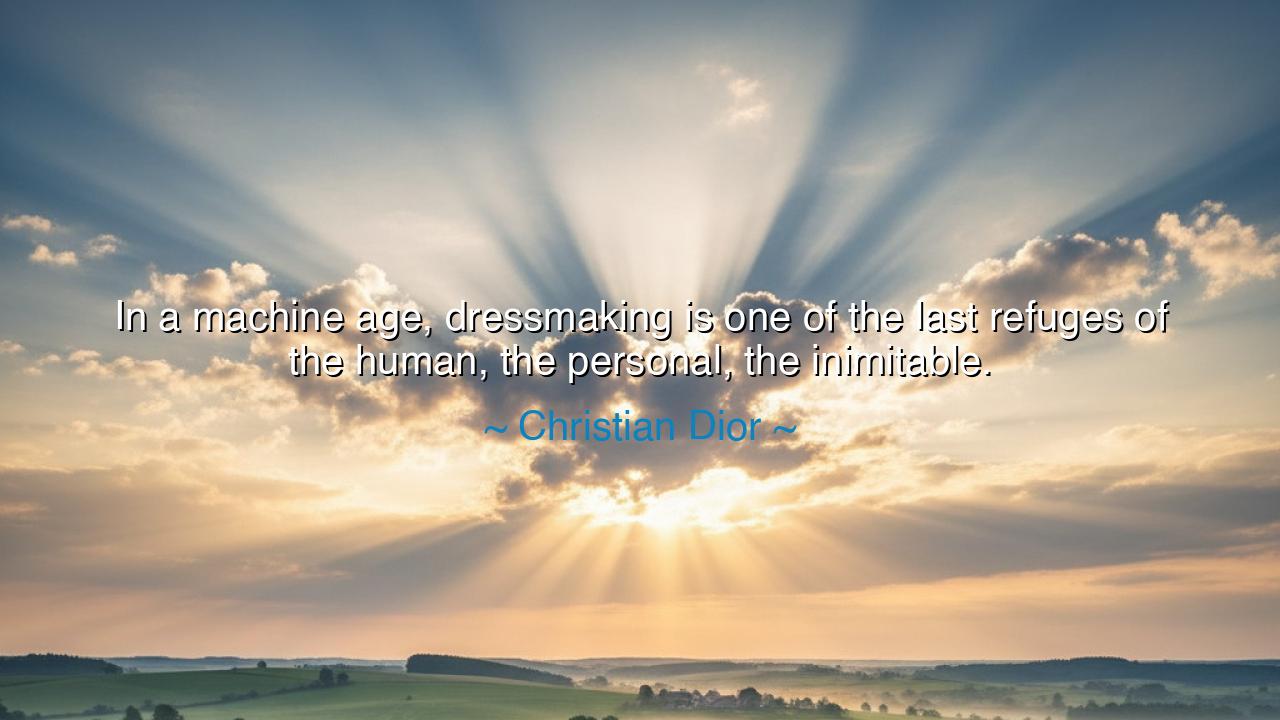
In a machine age, dressmaking is one of the last refuges of the
In a machine age, dressmaking is one of the last refuges of the human, the personal, the inimitable.






“In a machine age, dressmaking is one of the last refuges of the human, the personal, the inimitable.”
Thus spoke Christian Dior, the great architect of elegance, who revived beauty in a world weary from war. In these words, he mourns and celebrates all at once: he mourns the growing reign of mechanization, which strips the world of its soul, and celebrates the enduring flame of the human touch, which still lingers in the art of creation. For in an age where metal hums and engines labor without rest, he reminds us that there remain sanctuaries where the hand, the heart, and the spirit still rule.
When Dior speaks of dressmaking as “the last refuge,” he means more than the crafting of garments; he speaks of the human act of creation itself—an act born not from programming, but from intuition. Machines may copy patterns and replicate designs, but they cannot dream. They cannot feel the tremor of silk beneath the fingers, nor sense when a curve or stitch becomes poetry. In every dress shaped by a human hand lies a secret conversation between maker and creation. This is what Dior calls the personal—the breath of life that no mechanism can imitate.
In the world that Dior inherited—the postwar age, where factories rose like iron forests—efficiency became the new god. The machine promised perfection and speed, but it also stole from man his individuality. Amidst this, Dior’s atelier stood like a temple of resistance. His creations—the “New Look” with its sweeping skirts and radiant silhouettes—were not mere garments but acts of defiance. They reclaimed beauty, emotion, and the delicate imperfection that only human hands can achieve. In the click of every needle, Dior whispered: The soul is not obsolete.
History offers us many such sanctuaries of the human spirit. In the Renaissance, when printing presses began to multiply books by the thousands, manuscript illuminators—those who painted gold upon parchment—became relics of the old world. Yet their work, slow and sacred, retained a splendor untouched by mass production. Likewise, in our own time, artisans, poets, and musicians carry on that eternal struggle: to keep art alive, not merely produced. As the ancients once said, “The gods dwell where hands still labor in love.” Dior’s words echo this truth: the divine lives in craft, in touch, in care.
To call something inimitable is to declare it beyond replication. The inimitable is what no machine, no algorithm, no system can reproduce, for it belongs not to process but to soul. It is the uneven stitch that gives a dress its character, the spontaneous brushstroke that turns a painting into revelation. In a world obsessed with precision, the human remains sacred precisely because it errs, because it feels. Dior saw this: that in imperfection lies divinity, and in individuality lies beauty.
Let this truth be a beacon to all who live in the mechanical age. Do not surrender your spirit to the gears of conformity. Cherish the handmade, the personal, the work that bears your signature of imperfection. Whether you build, write, cook, or sew, let your labor carry the warmth of your humanity. Machines may serve us, but they must never replace us. For when the human touch disappears, beauty fades into uniformity—and the world becomes gray.
Practical teaching: Seek always to create with your hands, your mind, and your heart together. If you must use the tools of the age, let them serve your vision, not rule it. Value what is slow, deliberate, and made with love. Support the craftsman, the artist, the tailor—the keepers of the human flame. For as Dior reminds us, in a world of endless machines, the most revolutionary act is to remain deeply, unapologetically human.






AAdministratorAdministrator
Welcome, honored guests. Please leave a comment, we will respond soon